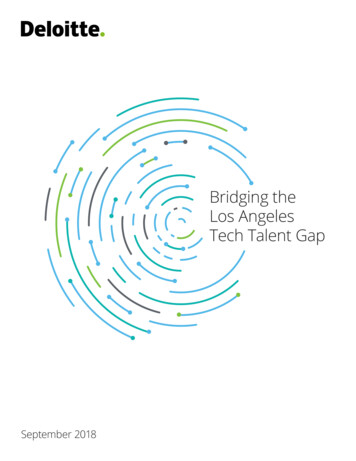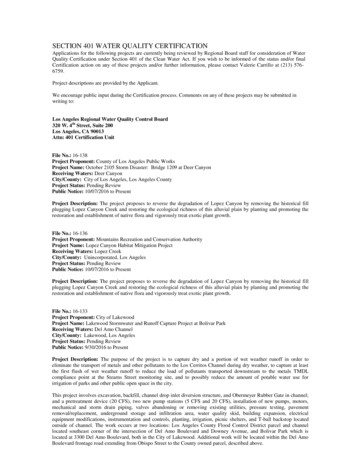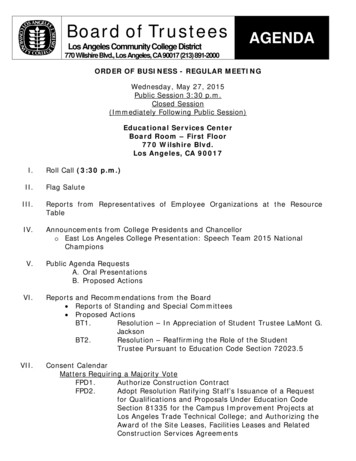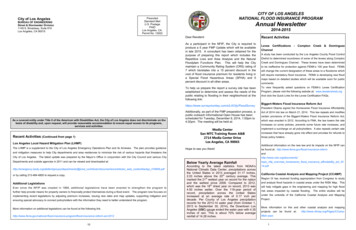
Transcription
Bridging theLos AngelesTech Talent GapSeptember 2018
Bridging the Los Angeles Tech Talent GapTable of contentsChapter 1: Executive summary .2Chapter 2: LA tech market – where it is and where it’s going.3The LA labor market. 3LA tech jobs. 4Chapter 3: Understanding the tech talent gap.5Contributing factors. 5Examples of current initiatives. 6Chapter 4: Bridging the talent gap .7The coalition. 7Coalition Structure. 8Roles and responsibilities. 8Coalition roadmap. 9Phase One. 10Phase Two. 12Chapter 5: Value proposition – benefits and outcomes.13Employers. 13Education institutions. 13Intermediaries. 14Chapter 6: Conclusion.15Appendix.16Endnote.191
Addressing the technology skills gap in Los AngelesChapter 1: Executive summaryLos Angeles (“LA”) distinguishes itself as theentertainment capital of the world. In recentyears, the region has also been emergingas an epicenter for technology (“tech”)companies, which gave rise to tech jobsboth within and outside the tech industry.Its proximity to one of the nation’s largestairports and ports of entry, its diverseculture and abundance of creativity hasmade it an attractive alternative for bothstart-ups and Fortune 500 companies tooperate. The increase in the number ofcompanies operating in LA translates toa rise in job opportunities and needs fortech positions.To continue to attract Fortune 500companies, LA must solve the challenge ofprojected supply of tech talent not keepingpace with increasing demand. Currently,educational institutions have difficultydeveloping a standardized career pathwayfor tech job seekers and employers do nothave access to a strong pipeline of localtalent.This problem is starting to be addressed.Corporations and education institutionshave begun addressing the talent gapthrough increased one-on-one partnershipsto develop work-based learningopportunities. Intermediaries, defined asorganizations that facilitate partnership2opportunities, play a vital role in bringingtogether these stakeholders and helpto bridge gaps in communication. Thesebilateral partnerships are important stepsto addressing the talent gap; however, thesepartnerships tend to solve problems thatare not scalable and there needs to be abroader effort to address the systemicroot of the talent gap. Today’s and futuretalent in LA needs an updated and moredynamic educational curriculum, morework-based learning opportunities,increased company awareness ofnontraditional applicant pools, andstudent awareness of tech careers.These challenges can be addressed througha collaborative coalition effort, led by anintermediary who can facilitate the exchangeof information between the tech industryand educational institutions.This paper provides a road map todevelop a coalition - a multilateralpartnership effort across educationinstitutions, tech employers,intermediaries, and governmentinstitutions to address the underlyingfactors causing the talent gap. Acoalition amongst these groups will provideeducational institutions and employers theability to develop a continuous pipeline ofhighly qualified, local tech talent through:Increasing awareness of techindustry’s current hiring needs andin-demand skill setsIncreasing work-based learningopportunities with focus ondeveloping both soft and hard skillsfor students across K-12, colleges,and universities to supplementexisting curriculum materialProviding opportunities to bring anindustry presence into classroomsto engage students and fosterinterest in pursuing tech careersIncreasing faculty and educationalinstitution awareness of thereal-world working environmentto better prepare students fortransitioning into professional lifeoutside of schoolDeveloping “points of contact”inside local educational institutionsthat can liaise with industryintermediaries and tech employers
Bridging the Los Angeles Tech Talent GapChapter 2: LA tech market – where it is and whereit’s goingLA is emerging as a tech hotbed for startups and large corporations. Historicallyknown as the heart of entertainment andmedia in the United States, the city hasalways embraced an influx of innovative andcreative minds. As a result, an increasingnumber of tech companies, accelerators,and incubators have made LA theirbase of operations. This intersection ofentertainment and tech, coupled with LA’sculture of innovation, position the region tobe one of the most dynamic tech hubs in thenation.The LA labor marketLA represents the third largest metropolitaneconomy in the worldi with five millionemployees.ii It is the third largest techecosystem in the United Statesiii and in 2017,the 100 biggest tech companies in LA andOrange Counties reported an increase of24% more employees than the previousyear.iv With the increase of tech companiesin the region, there is a growing demand fortech labor. The Bureau of Labor Statistics(BLS) estimates that by 2024, there willbe 133,870 Information Technology (IT),engineering, and digital media jobs in LACounty, an increase from 115,770 as of80%Of tech talent in LA isworking outside of thesoftware and IT industrySource: LinkedIn3the end of 2014.v Additionally, accordingto a recent report by LinkedIn on the LAlabor market, the most scarce skill in LA,defined as demand exceeding supply, is ITand infrastructure management.vi Thesejobs present an opportunity for the LAcommunity to meet the demand for laborwith local talent.To maximize the return on investmentof recruitment dollars, tech employerscontinue to seek opportunities to employlocal talent to fill these positions. The LAeducation system produces one of thelargest supplies of labor in California. ThePublic Policy Institute of California noted thatLA County accounted for 24% of Bachelor’sdegrees awarded during 2015 and 2016 inthe state, and the number of graduates willcontinue to rise within the LA college anduniversity systems.vii Within the communitycollege system, the California CommunityColleges Chancellor’s Office anticipatesenrollment to increase by 15% on its LA andVentura county campuses between 2013and 2023.viiiThe increase in enrollment numbersacross two-year and four-year educationinstitutions will provide tech companiesan opportunity to secure a local pipelineof highly qualified talent. Employers canidentify quality talent prior to graduationand prepare these students with therequired skill sets to transition directlyinto high-demand tech positions upongraduation.Los Angeles - Economy5 million workers133,870: number ofIT jobs projected in 2024(current: 133,870)#1 creative economy,international trade economy,and manufacturing economyin the nationLos Angeles Educational Intitutions120 colleges anduniversities; 3 top researchuniversities (UCLA, USC,Caltech)15% increase in CommunityCollege enrollment from 2013to 2023Source: LAEDCii, BLSix
Bridging the Los Angeles Tech Talent GapLA tech jobsLA’s booming tech scene, nicknamed “Silicon Beach,” is located in the coastal area north ofLA airport. Large tech firms, including YouTube, Google, Yahoo, BuzzFeed, and Snap, haveall settled in the area to conduct business operations.x This in turn has attracted othercompanies outside of tech that need tech talent to move into the region. As of August2018, LinkedIn data shows that Los Angles has approximately 38,000 companies employingtech talent and that 74% of employees with tech jobs work outside of the software and ITindustry xi.According to the 2016 Built in LA report, an online community where tech companies in LApost jobs and discuss company culture, investors poured 4.2 billion into 213 LA-based techcompanies - up 38% from dollars raised in 2015.xii With this continuing trend, the city willcontinue to serve as a launch pad for both new tech companies and established companiesto grow its operations. As the LA tech industry grows, a talent gap could affect companyproductivity.Comparing the LA tech ecosystem to similar cities helps put the city’s rapid growth intoperspective. There are four other notable tech hubs in the United States: San Francisco’sSilicon Valley, Austin, Seattle, and New York City. While Silicon Valley continues to lead inattracting investment dollars, 6.5 billion in venture funding last year, compared to LA’s 4.2 billionxiii, LA is beginning to distinguish itself from the other cities. LA has more tech jobopportunities when compared to the other major tech hubs of Austinxiv, Seattlexv, and NewYork City xvi. The figure below illustrates that LA’s job market continues to outpace most othertech hubs in the United States.Top high-growth tech jobs inLos Angeles1.2.3.4.Software Developers, ApplicationsComputer User Support SpecialistsComputer Systems AnalystsSoftware Developers, SystemsSoftware5. Web DevelopersSource: BLSTop LA-Based Companies Hiring TechTalent as of August 20181.2.3.4.5.6.7.8.9.10.NASA Jet Propulsion LaboratoryEsriThe Walt Disney CompanySpaceXSouthern California EdisonDIRECTVUSCUCLASnap, Inc.AmgenSource: LinkedInComparison of Tech Jobs in the U.S.Seattle # of tech employees: 144,200 Average Tech Salary: 88,587 Tech workers per 1,000 jobs: 78Los Angeles # of tech employees: 115, 770 Average Tech Salary: 97,281 Tech workers per 1,000 jobs: 30New York City # of tech employees: 266,720 Average Tech Salary: 79,583 Tech workers per 1,000 jobs: 35Silicon Valley # of tech employees: 253,180 Average Tech Salary: 101,083 Tech workers per 1,000 jobs: 73Austin # of tech employees: 65,960 Average Tech Salary: 98,672 Tech workers per 1,000 jobs: 62Source: BLS, NerdWallet xvii4
Bridging the Los Angeles Tech Talent GapChapter 3: Understanding the tech talent gapSilicon Beach’s economic boom hasincreased the demand for quality techtalent. Hiring top caliber talent is crucial forcompanies looking to develop cutting-edgetech. However, companies are facing thechallenge of finding sufficient talent to filltech roles and thus stay competitive.xviiiAt the same time, the LA education systemis facing the challenge of expanding anddeveloping its tech talent supply to meetlabor demand across entry-, middle-, andmanagement-level job positions. Analyzingthe contributing factors to the tech talentgap can help build the framework for solvingthe issue.Contributing factors1. Changes in tech industry outpacescurriculum updatesChanges in skill sets demanded inthe tech industry constantly evolve,often outpacing the curriculum updateprocess. According to an article by WallStreet Journal, 52% of US companiesreport difficulty filling tech jobs, and 47%of companies site a lack of technical skillsas the reason.xix The lack of technicalskills could be traced back to outdatedcurriculum that make it difficult for jobseekers to keep their skill sets currentand relevant to the needs of theindustry. The constant advances in techresult in gaps between skills demandedversus skills acquired. Communicationchallenges between employers andeducation institutions contribute to thetalent gap and is a factor in keeping thecurriculum up to date.2. Limited student exposure andawareness to tech career pathsTechnical education needs to start earlyto get students to choose a tech careerpath. Further, exposure to tech skillsis not consistent across K-12, colleges,and universities. As a result, studentshave limited awareness of tech careersand the pathway to obtaining jobs inthe tech industry. Students that areexposed to tech careers in college forthe first time will be at a competitive5disadvantage because their ability toaccess networks to obtain work-basedlearning opportunities will be limited.3. Difficulties recruiting and findinghidden talentTech employers are challengedto identify hidden talent fromnontraditional sources. This challengecould be due to a variety of factors,including lack of familiarity with thetalent pool, lack of systems to filterqualified students from the large poolof students in public colleges, and anover-reliance on credentials that may notalign with the actual skills required forentry-level positions. While employerscite hard skills as being a necessary skillset for a job, numerous employers citethat soft skills are even more important.Therefore, companies should widen theaperture of the candidates they considercapable of filling and growing into openroles.53% of tech talent in LA donot list a 4-year degreeSource: LinkedIn4. Need for more work-based learningand job preparedness opportunitiesAccording to research by StanfordUniversity, work-based learning canhelp make educational programsmore relevant and may help increasegraduation rates. xxii There is currentlya lack of work-based learningopportunities available to students tosupplement existing curriculum in theLA market. Without work-based learning,students have a harder time makingcareer decisions, networking withpotential employers, and developing jobskills relevant to future employment.Further, companies are missing anadditional opportunity to mentor anddevelop local resources.Changes intech industryoutpacescurriculumcpdatesDifficulties inrecruiting andidentifying qualifiedtalentTech talentgapframeworkLimited studentexposure andawareness totechnologycareer pathInconsistentopportunities forwork-basedlearning and jobpreparednessIn order to lessen thetalent gap in LA and meetemployer demand, it isimperative to anticipateand develop the workforce of thefuture. Google found that 98% of its USemployees were exposed to computerscience prior to college.xx Additionally,those who studied computer science incollege were more likely to have learnedabout that career path in high school.This type of early exposure to computerscience increases student confidenceand awareness of the lucrative careerpaths in IT. According to code.org, only580 schools in California (25% of CAschools with AP programs) offered anAP Computer Science course in2016-2017, which is 210 more than theprevious year.xxi It seems as if highschools are taking steps in the rightdirection to incorporate computerscience into the curriculum, but it is farfrom ubiquitous. Early exposure tocomputer science and tech careerpathways is crucial in developing thefuture workforce.
Bridging the Los Angeles Tech Talent GapExamples of current initiativesThe LA community has started takingsteps to address the tech talent challenge.Over the last few years, tech employers,educational institutions, nonprofits, andgovernment stakeholders have developedpartnerships to address the tech skills gaps.Some employers have made investmentsat community colleges and universities toprovide work-based learning opportunities.Additionally, intermediaries have played keyroles in facilitating opportunities to partnerbusinesses with education institutions tobetter prepare students for a tech career.LA HI-TECHThe Los Angeles High-ImpactInformation Technology, Entertainment& Entrepreneurship, and CommunicationHubs (LA-HI TECH) is a regional consortiumthat has the goal of sustaining economicvitality of a skilled and competitive workforcethat contributes to the economic growthof the tech industry in LA. The consortiumpairs Community Colleges with high schoolsto link students to three career pathwayswithin Information and CommunicationTechnology studies: 1) Design, Visual, andMedia Arts; 2) Information Support andServices; and 3) Software Systems andDevelopment. LA HI-TECH mission is to buildrobust partnerships, provides supplementalinstruction, and increases student successin tech learning.xxiiiBixel Exchange: Center for Innovation &Technology at the L.A. Area ChamberBixel Exchange is hosted by the L.A. AreaChamber of Commerce and was launchedthree years ago with the goal of cultivatingtech talent in an effort to create a moreprosperous LA. Bixel Exchange has twoprimary initiatives to achieving its goal; the‘LA Tech Talent Pipeline’ to connect techemployers to diverse and underrepresentedstudents and the ‘Startup LAunch SBDC’that helps entrepreneurs launch and scaletheir businesses through mentorship andno-cost incubation.xxiv6Spotlight #1: Snap, Inc. Careers Ladder ProjectBackground: : LA HI-TECH and Snap, Inc. partnered to pilot a program at a Piercecommunity college, where Snap led a design competition to engage students in digitalmedia technology.Key Activities: Snap, Inc. led an 8-week design competition, where employees taught4-hour sessions. These sessions gave students a chance to learn-by-doing in animmersive setting and ultimately led to half of the students applying to the coding bootcamp hosted at the college.Outcome: Because of the workshop, students were able to add the project to theirportfolios and there was an increase of interest in the school’s design and media artsprogram. This type of mutually beneficial approach to work-based learning couldbe instrumental in helping narrow the skills gap in Los Angeles. Snap has acted as apioneer for stakeholder collaboration and strengthened its relationship with localeducational institutions and is gaining exposure to a fruitful, non-traditional talentpipeline.Spotlight #2: Amazon Web Services Partnership with Santa Monica CommunityCollegeBackground:: Amazon and Santa Monica Community College partnered on anopportunity through Amazons’ Amazon Web Services (AWS) Educate grant program toprovide a unique certification program. The purpose of this partnership was to increaseawareness of its public cloud services in the educational community.Key Activity: Amazon and Santa Monica Community College faculty incorporatedan accelerated cloud-related learning program linked to AWS into an existingcurriculum. Some example courses created through the partnership include: ComputerEngineering, Database Essentials, and Security.Outcome: As a result of this partnership, 50% of students participating in this programenrolled in Santa Monica Community College’s coding boot camp. This case is anexample of a program that can be scaled and replicated at other academic institutionsas Amazon has developed a curriculum that can be readily accessed by other potentialpartner institutions and students. This partnership provided students exposure toopportunities to learn niche skillsets across large, specialized tech companies.
Bridging the Los Angeles Tech Talent GapChapter 4: Bridging the talent gapWhile partnerships between schools and employers have yielded internships and jobplacements, these one-off partnerships alone will not solve the talent gap. To scale thebenefits of these partnerships, education institutions and employers should come togetheras a group to address this skills gap as one unit. From discussion with stakeholders, previousinitiatives have struggled to make meaningful progress due to the missing stakeholdersinvolved in the discussion, lack of a clear decision maker, lack of adequate funding,accountability, and a “check the box” mentality for participants. Creating a coalition can allowa forum for employers and education institutions to address the tech skills gap in a unifiedand tactical way, ultimately benefiting all parties involved.Key activitiesProvide a forumIdentify opportunities forcollaborationProvide resourcesThe coalitionTo have a successful convening, an infrastructure that builds from existing partnershipsneeds to be established. The coalition should focus on a multilateral effort, with involvementfrom members of the LA educational system, tech industry, private sector and governmentalintermediaries working together to address the systemic root causes of the talent gap. Thecoalition would be setup to have multiple meetings throughout the year, from strategicmeetings with lots of stakeholders to smaller focus group meetings to make sure there isrelevant discussions for all individuals attending. The coalition can play a vital role in bridgingcommunication between employers, intermediaries, and education institutions to align onthe overarching mission and strategic priorities in order to achieve desired outcomes.Establish champions andpoint of contactsCoalitionMission:Enable education institutions and employers to prepare students for a professionalcareer to meet the rising demand for skilled labor to fill technology jobs in LA.InputsLabor MarketDataUnderstandingHiring Needs andSkillsetsIndustry SubjectMatter Knowledgeto ic PrioritiesTalentPipelineSupport the developmentof career pathways throughtalent pipeline programsand activities such as workbased learning, internships,and job placementEmployers Provide hiring needsand skillset information Provides volunteers andchampions to supportcoalition initiativesInformationExchangeFacilitate informationexchange betweenemployers and educationinstitutions to supplementand re-envision existingcurriculumIntermediaries Translate hiring needsand requirements toeducational institutions Facilitate the establishment of employer-toeducation partnerships Provide resourcesupport as needed toexecute initiatives Ensure public policy isaligned with needs ofemployers andeducational institutionsChampionNetworkBuild and enable a networkof champions by increasingthe number and empowering education and employerpartnerships in the local LAtechnology communityEducationalInstitutions Provide access tostudents Identify and collaborateon opportunities toincorporate work-basedlearning opportunitiesinto existing curriculum Promote coalitioninitiatives to student mentJobPlacementUpdatedEducationalCurriculum
Bridging the Los Angeles Tech Talent GapCoalition StructureThe coalition should be set up to recognize multiple centers of leadership, each of which can be organized by common principles andinterests. Traditionally, coalitions are set up as a hierarchy. However, in the proposed structure, existing organizations (e.g., LAUSD/k-12, ITagencies, and tech companies) are the leaders and the coalition supports their evolving needs. This convening represents an opportunityboth to unite current efforts being taken to address the talent gap under a centralized platform and to integrate current successfulprograms into coalition initiatives.For example, LA HI-TECH is a consortium that pairs Community Colleges with high schools to link students to pathways within Informationand Communication Technology studies. The coalition could efficiently structure meetings by connecting relevant stakeholders – in thiscase Community Colleges, tech companies, and nonprofits.FunctionRoleRoles and responsibilitiesTo operate effectively, it is important to establish key roles and responsibilities within the coalition.xxv Key positions for the coalition shouldinclude the following. These positions are not necessarily mutually exclusive, and individual members could serve in multiple roles.Coordinator Lead and coordinate thecoalition Lead selected coalitionactivity Ensure coalition membersare included in all relevantdiscussions Provide key inputs tocoalition initiatives Provide input to coalitioninitiatives Serve as cohesive voice Facilitate decision making.8Initiative leaders Identify resources tosupport execution of keyinitiativesFacilitators Lead coalition meetingsand promote activediscussion amongst allstakeholders.Volunteers Participate in coalitionmeetings and support theplanning and execution ofkey initiatives.
Bridging the Los Angeles Tech Talent GapCoalition roadmapTo establish a successful collation, a road map to implementing the coalition is shown in Figure 1 below and consists of two highlevel phases: Phase 1: Establish a coalition: Identify coalition members and set the strategy that will accomplish stakeholder’s prioritiesand key goals for the calendar year. Phase 2: Manage coalition and track performance: Execute initiatives and monitor progress toward meeting coalition yearend goals.Figure 1 - Illustrative coalition roadmap9Phase 1 : Establish acoalitionPhase 2 : Manage coalitionand track performanceStep 1:Develop an incentiveprogramStep 1:Execute initiative-specificaction plansStep 2:Recruit coalitionmembersStep 2:Support coalitionmembers' effortsStep 3:Align stakeholder prioritiesStep 3:Trackperformance
Bridging the Los Angeles Tech Talent GapPhaseOneESTABLISH COALITIONPhase 1 focuses on setting the strategy and planning activities toorganize the coalition. In order for the coalition to be successful,stakeholders should be prepared to contribute the following:Employers: Provide hiring needs and skill set information Provide volunteers and champions to support initiatives Collaborate to establish work-based learning opportunitiesIntermediaries: Translate hiring needs to educational institutions Facilitate establishment of employer-to-education partnerships Provide resource support as needed to execute initiativesEducation Institutions: Create flexible curriculum to accommodate evolving tech skills Identify and collaborate on opportunities to incorporate workbased learning opportunities into existing curriculum Promote coalition activities to student bodyThere are three key steps that should be completed prior to movingto phase 2.Step 1 — Develop an incentive program to encouragemembers to join.Intermediaries collaborate with the LA Area Chamber of Commerce("LA Chamber") to develop a LA Community Partner RecognitionProgram that rewards active employers and education institutionsfor their involvement in coalition initiatives. Intermediaries willwork with the LA Chamber to build a framework for the recognitionprogram. The framework could include specific performance criteriathat can be satisfied to qualify for a certificate of recognition.Recommendation #1: Establish a LA Community PartnerRecognition ProgramPotential areas include, but are not limited to: Internship/job placement numbers Number of students impacted Number of full-time participants and volunteers Attendance in coalition meetings and eventsEmployer specific: Number of engagements with students (e.g., workshops and jobpanels) Dollars invested in the coalitionEducation institution specific: Number of specialty skill classes held Tech-focused certificate programsGovernment specific: Create framework to have coalition members formallyrecognized as a community partner by a government office foraddressing the skills gap10Step 2 — Recruit coalition members.Intermediaries play a key role in identifying and recruiting coalitionmembers. These entities have in-depth understanding of the LA techindustry landscape and can identify key decision makers and largetech companies to join the effort.Recommendation #2: Recruit key decision makers andinfluencers into the coalitionTo expedite the decision-making process, coalition membersshould be a combination of decision makers and key influencersfrom employers and education institutions, such as the following: Employers–– Hiring manager (with Engineering or IT department)–– Diversity and inclusion leadership–– Chief Human Capital Officer–– Community and Government Relations K-12 Education Institutions–– School District Administrators–– Principal–– Curriculum advisor Colleges and Universities–– College president–– Dean/chair of engineering, computer science and otherrelevant college(s) and departments–– Faculty–– Career placement advisor Non-Profit Organizations (to include funders)–– Bixel Exchange–– Center for Competitive Workforce–– LA HI-TECH–– Opportunity @ Work–– JP Morgan Chase–– Kresge Foundation–– California Department of Education–– Mayor's officeNote: This list is for illustration purposes only and is not anexhaustive list of all stakeholders
Bridging the Los Angeles Tech Talent GapStep 3 — Align stakeholder priorities with coalition initiatives.In a strategy session, coalition members can coordinate to accomplish common goals andhow to best leverage the coalition to move forward. The strategy session should focus oncompleting the following activities: Understand Stakeholder Priorities. As an example, employers may share data on theirrespective profile of a qualified candidate – soft and hard skill qualities that successfulemployees typically demonstrate for entry-level positions. Conversely, educationinstitutions can use this session to understand the type of prep
Los Angeles - Economy 5 million workers 133,870: number of IT jobs projected in 2024 (current: 133,870) #1 creative economy, international trade economy, and manufacturing economy in the nation Los Angeles - Educational Intitutions 120 colleges and universities; 3 top research universities (UCLA, USC, Caltech) 15% increase in Community










